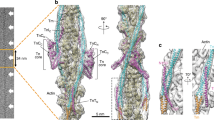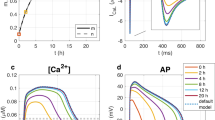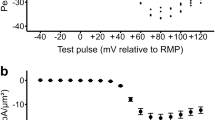Abstract
The importance of the slow inward calcium current (Isi) in the excitation–contraction coupling process of cardiac muscle is well documented1,2. The current can be attributed mainly to a calcium translocation from the extracellular space into the cell or a subsarcolemmal compartment of it3,4. Isi has been suggested to have its source in and to be controlled by the surface coat of the sarcolemma (glycocalyx)5. The glycocalyx is destroyed in myocytes dissociated from adult heart tissue with solutions containing low calcium, collagenase and hyaluronidase6,7 (Fig. 1). By comparing the Isi data obtained in isolated myocytes with those reported for trabeculae or papillary muscles, we have now obtained evidence suggesting that the glycocalyx is not important in the genesis of Isi.
This is a preview of subscription content, access via your institution
Access options
Subscribe to this journal
Receive 51 print issues and online access
$199.00 per year
only $3.90 per issue
Buy this article
- Purchase on Springer Link
- Instant access to full article PDF
Prices may be subject to local taxes which are calculated during checkout
Similar content being viewed by others
References
Reuter, H. & Scholz, H. J. Physiol., Lond. 264, 7–47 (1977).
Reuter, H. A. Rev. Physiol. 41, 413–424 (1979).
Bassingthwaight, J. B. & Reuter, H. in Electrical Phenomena of the Heart (ed. DeMello, W. P.) 353–395 (Academic, New York, 1972).
Trautwein, W., McDonald, T. F. & Tripathi, O. Pflügers Arch. ges. Physiol. 354, 55–74 (1975).
Langer, G. A. A. Rev. Physiol. 35, 55–86 (1973); Fedn Proc. 35, 1274–1278 (1976); Am. J. Physiol. 235, H 461–H 468 (1978).
Carlson, E. C. et al. J. molec. cell. Cardiol. 10, 449–459 (1978).
Vahouny, G. V., Wei, R. W., Tamboli, A. & Albert, E. N. J. molec. cell. Cardiol. 11, 339–357 (1979).
Glick, M. R., Burns, A. H. & Reddy, W. J. Analyt. Biochem. 61, 32–42 (1974).
Zimmerman, A. N. E. & Hülsmann, W. E. Nature 211, 646–647 (1966).
Powell, T., Terrar, D. A. & Twist, V. W. J. Physiol., Lond. 282, 23–24P (1978); J. Physiol., Lond. 284, 148 (1978).
Lee, K. S., Weeks, T. A., Kao, R. L., Akaike, V. & Brown, A. M. Nature 278, 269–271 (1979).
McDonald, T. F. & Trautwein, W. J. Physiol., Lond. 274, 193–216 (1978); J. molec. cell. Cardiol. 10, 387–394 (1978).
Kohlhardt, M., Bauer, B., Krause, H. & Fleckenstein, A. Pflügers Arch. ges. Physiol. 335, 309–322 (1972).
Besseau, A. & Bargouil, Y. M. J. Physiol., Lond. 204, 95–96 (1969).
Leoty, C. J. Physiol., Lond. 239, 237–249 (1974).
Payet, M. D., Schanne, O. F., Ruiz-Ceretti, E. & Demers, J. M. J. Physiol., Paris 74, 31–35 (1978).
Frank, J. S., Langer, G. A., Nudd, L. M. & Seraydarin, K. Circulation Res. 41, 702–744 (1977).
Dreyer, F. & Peper, K. Pflügers Arch. ges. Physiol. 348, 263–272 (1974).
Isenberg, G. Pflügers Arch. ges. Physiol. 380, 91–98 (1979).
Author information
Authors and Affiliations
Rights and permissions
About this article
Cite this article
Isenberg, G., Klöckner, U. Glycocalyx is not required for slow inward calcium current in isolated rat heart myocytes. Nature 284, 358–360 (1980). https://doi.org/10.1038/284358a0
Received:
Accepted:
Issue Date:
DOI: https://doi.org/10.1038/284358a0
This article is cited by
-
Barium- and calcium-permeable channels open at negative membrane potentials in rat ventricular myocytes
The Journal of Membrane Biology (1989)
-
Block of single cardiac Na+ channels by antiarrhythmic drugs: The effect of amiodarone, propafenone and diprafenone
The Journal of Membrane Biology (1988)
-
Are isolated cardiomyocytes a suitable experimental model in all lines of investigation in basic cardiology?
Basic Research in Cardiology (1988)
-
ATP-sensitive K+ channels in rat ventricular myocytes are blocked and inactivated by internal divalent cations
Pfl�gers Archiv European Journal of Physiology (1987)
Comments
By submitting a comment you agree to abide by our Terms and Community Guidelines. If you find something abusive or that does not comply with our terms or guidelines please flag it as inappropriate.



